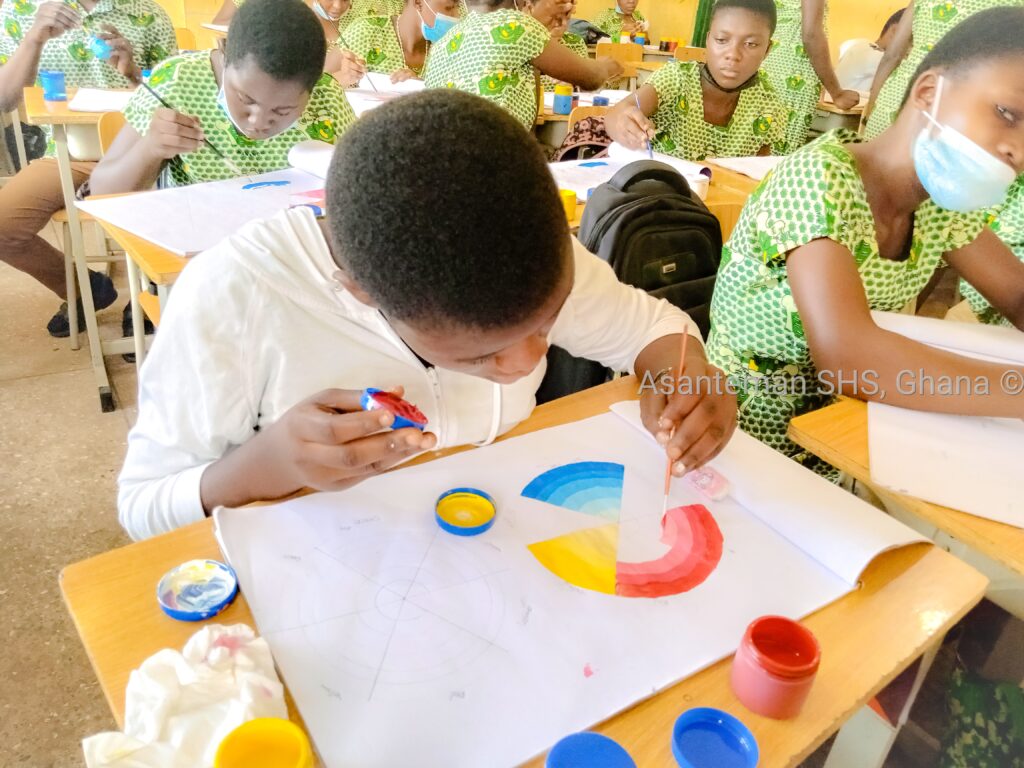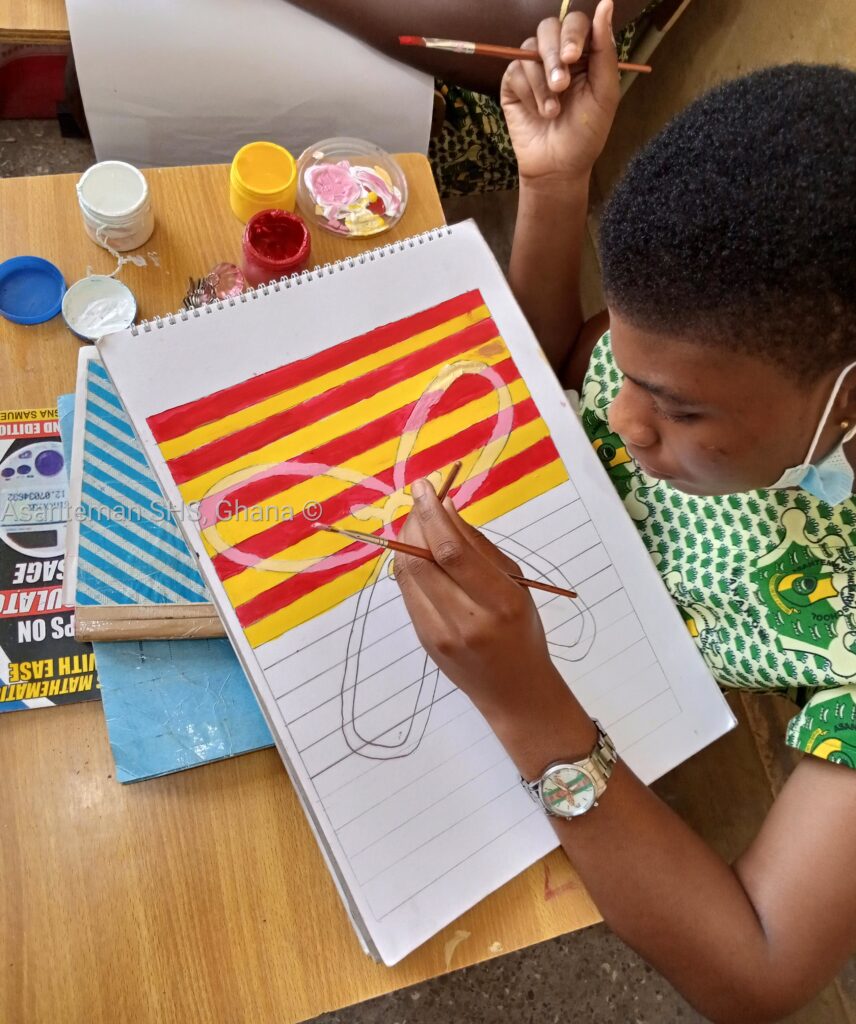‘Teaching High School Art in Ghana’ | Kumasi
Sintim Isaac, serving as a teaching assistant for a year, talks about his work at a high school in the Ashanti region of Ghana and presents the work of his students. Although he is not a permanent staff member, he wants to leave a mark during his time there. His goal is to help students develop basic skills and help them to understand the value of their artwork.
 I am a teaching assistant at Asanteman Senior High School, founded in 1954 by an Asante Youth Association, located at Suame Kumasi, Ashanti Region. It was established to meet the growing demand for secondary education for both male and female youth. Founding headmaster, the late Mr. J. Owusu Ofori, was dedicated to building the minds and character of the students.
I am a teaching assistant at Asanteman Senior High School, founded in 1954 by an Asante Youth Association, located at Suame Kumasi, Ashanti Region. It was established to meet the growing demand for secondary education for both male and female youth. Founding headmaster, the late Mr. J. Owusu Ofori, was dedicated to building the minds and character of the students.
The School offers a three-year program with a general core curriculum and a range of courses that includes visual arts. Graphic design and general knowledge in art are the core elective subjects all visual art students study. Each level has classes in fine and industrial arts. Fine Arts includes sculpture and picture making. Industrial Arts includes ceramics and textiles.
I teach one-hundred students General Knowledge Art (GKA). This includes lettering, the history of both African art and the world, along with other art essentials like colour, a variety of art media and art forms to help students develop their creativity and technical skills. For example, to complement their study of "Fashion and Textiles", GKA teaches how to achieve harmony of colours and fashion-design illustration.
The fine arts curriculum offers a wide range of approaches and techniques. Students learn how to use dry (pastel, colored pencils, charcoals) and wet media (oils, acrylics and watercolors). 'Marquetry', the art form I use in my art practice, is included along with mixed media and techniques like collage, mosaics, illustration, pyrography, montage, print making and painting.
 ‘Achieving Color Harmony and Transparencies’ is a painting project I worked on with first year students recently, as a final lesson on ‘Color as an Element of Design’. It included Adinkra Symbols¹ as the main compositional element, intertwined with lines and enclosed in a shape. My objective was to help students learn about these symbols. I wanted them to learn symbol names and meanings, as well as to achieve color harmony by matching colors meaningfully to complement their subjects. We used acrylic paint and toned cartridge papers from Cadence Art And Hobby Paints, as well as brushes and pencils.
‘Achieving Color Harmony and Transparencies’ is a painting project I worked on with first year students recently, as a final lesson on ‘Color as an Element of Design’. It included Adinkra Symbols¹ as the main compositional element, intertwined with lines and enclosed in a shape. My objective was to help students learn about these symbols. I wanted them to learn symbol names and meanings, as well as to achieve color harmony by matching colors meaningfully to complement their subjects. We used acrylic paint and toned cartridge papers from Cadence Art And Hobby Paints, as well as brushes and pencils.
 I worked on this painting project with two classes, ninety-nine percent of them being females and the average age being seventeen years. I made an effort to design a creative environment for students to work in and aimed to boost their morale. I stressed how important it is to learn brush handling and being able to mix paint uniformly. This skill once acquired is not for academic purposes only but is a life skill they can build upon and even use to earn an income. It is not limited to their sketchpads. Designs can be transferred onto canvas, on the interior and exterior of houses of relatives and in the neighborhood where they live.
I worked on this painting project with two classes, ninety-nine percent of them being females and the average age being seventeen years. I made an effort to design a creative environment for students to work in and aimed to boost their morale. I stressed how important it is to learn brush handling and being able to mix paint uniformly. This skill once acquired is not for academic purposes only but is a life skill they can build upon and even use to earn an income. It is not limited to their sketchpads. Designs can be transferred onto canvas, on the interior and exterior of houses of relatives and in the neighborhood where they live.
For some students this was their first attempt at drawing and painting. My interest was in their choice of colors and willingness to explore. A happy teacher I was when the final paintings were displayed for appreciation and criticism.
Click here to see all of the artists with their art pieces
¹ Adinkra Symbols - are symbols from Ghana that represent concepts or aphorisms. They are used extensively in fabrics, logos and pottery and are incorporated into walls and other architectural features. Adinkra symbols were originally created by the Bono people of Gyaman, and Akan people of Ghana. Gyaman King Nana Kwadwo Agyemang Adinkra originally created or designed these symbols and named it after himself 'Adinkra'.
About The Artist
Sintim Isaac was born in the Ashanti region of Ghana. He earned his first degree (Second Class Upper Division) in Art Education from the University of Education, Winneba. He is currently a freelance artist working on his art practice and trying to grow his wood impression home studio. With his interest in teaching and impacting knowledge, he is available for any art-related teaching job and art classes. Sintim’s interest in Cubism influences his wood veneer paintings that stand out as unique.
His work is also influenced by deprived people and street children, roaming on streets, with no education and no future. The artist sympathizes with their struggle and isolation. Sintim has exhibited his artwork at the university’s art department, as well as through online platforms based in the US, India, and the UK. He received prestigious honors and awards throughout his student years and in 2021, he received the Artwaves Festival / Open Exhibition Judges Runner-Up Award.

